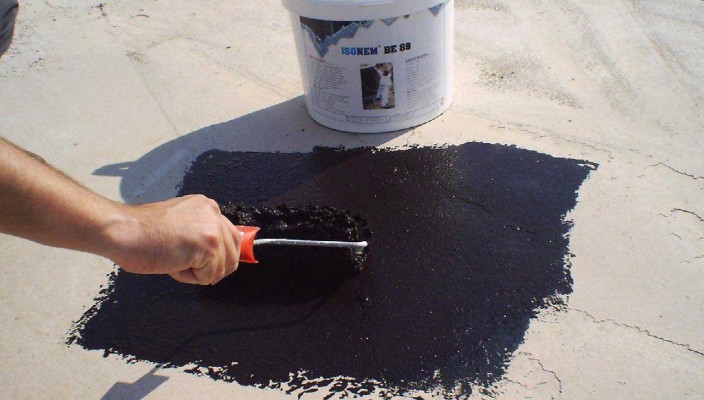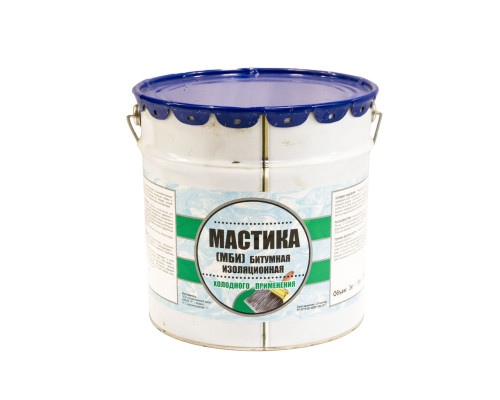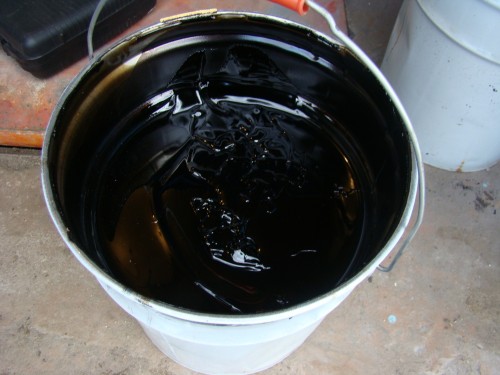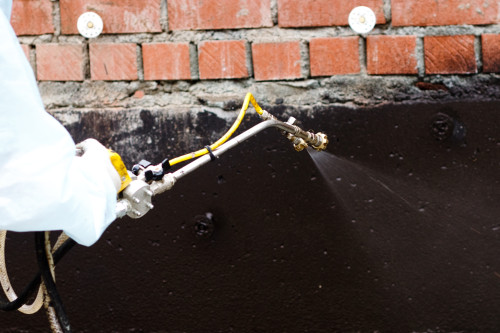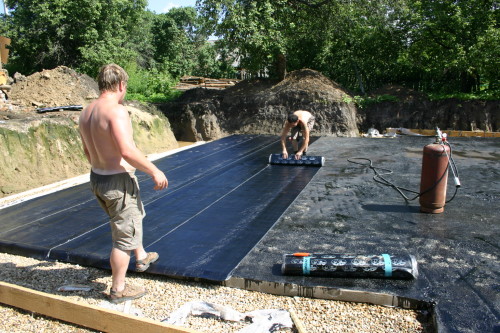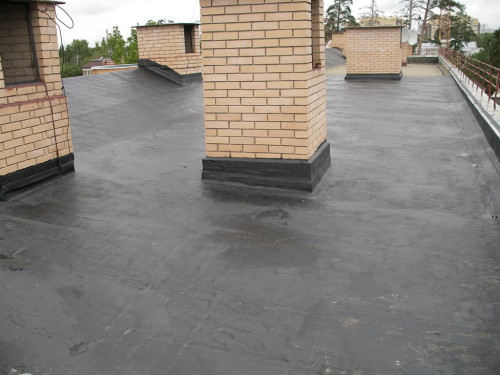The problem of isolation or repair of the roof, exposed to moisture, both inside and outside, often occurs during the construction and operation of the building. At the same time, many wonder: is there any other material, for example, for emergency roof repair, except bitumen? And how to carry out repair work, putting in a small amount for an ordinary person? There is a way out: the mastic bituminous roofing.
Content
General information about the material
Mastics are used to cover any kind of roof: a taught, metal, rolled, concrete or asbetic. At the same time, before work, it is not required to remove the old coating (except for the roofs where many layers of rubberoid were laid). The main difference between all types of mastic from rolled materials is that a monolithic coating is formed on the roof surface, like a film or membrane that protects the roof from the penetration of precipitation.
The mixture is one-component and two-component. The first is immediately ready for use and its stabilization is due to the evaporation of the solvent. Such material is supplied in a sealed capacity with a limited storage period, it is convenient to use it, but you cannot store in an open form.
Two-component mastic is supplied in the form of two chemically low-basic compositions, which individually can be stored for more than 12 months, which is an undoubted advantage, because it makes it possible to make the purchase of material in advance.
The amount of layers applied may vary depending on the irregularities of the source coating or the roof angle. If it exceeds 25 °, the use of roofing mastic is not recommended. Material, as part of which is oil, is frost-resistant.
By type of diluent, roofing masses are distinguished on water-containing, with organic solvents and containing organic liquid substances. All species are quickly stabilized, acquiring water resistance, strength and excellent adhesive ability.
Often separate roof nodes covered with mastic, reinforced to give strength. There are two basic material that uses for this:
- flusket. This is a high-strength network with a different cell size, woven from glass, which also has different thickness;
- glassball is a similar canvas, but with an arbitrary location of the fibers.
Since both materials are very durable, the elasticity of waterproofing is reduced. In this case, it should be selected for these works by mastic.
Tip: Mastic in combination with cement and sand gives a very durable elastic mixture.
The only lack of material on a bitumen basis is that in one approach it is difficult to obtain the uniformly required isolation thickness, especially if it comes to evasis-or uneven surfaces. In this case, two, or even three layers, which increases the material consumption.
Bitumen-polymer mastic
It is a semi-liquid black mass of cold use based on a modified bitumen.
Scope of mastic is very broad: used for waterproofing of walls, basement, basement, balcony, inter-panel joints, roofs and repair of old structures. It is used for waterproofing floors in rooms with high humidity. Due to the high degree of elasticity, even when a deep crack in a building sealant prevents the penetration of moisture. Therefore, its operational and technological properties fully meet the technical requirements.
The bitumen-polymer composition comprises a modified bitumen mastic, acrylate water emulsions, various plasticizers and adiativy.
In appearance and properties, mastic is applied to the surface of the roof, more like a sealant, rather than the usual for most of the bitumen. techniques developed by its use in the construction allow to obtain a reliable, seamless and durable insulation coating. This bituminous mastic, judging by the reviews, the most popular.
The advantages of the mastic:
- material is pleasant and convenient to use;
- it has excellent adhesion to most building materials: concrete, roofing material and even metal;
- it rests both on dry and on a wet surface;
- easy to apply in the most remote places;
- it does not require heating, unlike other roofing;
- it does not contain solvents, and therefore - is non-toxic, is possible to apply in confined areas;
- Not afraid of high temperatures: stably rests on vertical surfaces even at 120 ° C.
Before use, the mastic should be mixed thoroughly, if necessary, it can be diluted with solvent to the desired consistency (e.g., solvent, white spirit, nephras). Surface before treatment to dry, cleaned of dirt, dust, dirt, ice, and other contaminants. If the mixture is applied to the porous wall, it is first primed with a primer based on bitumen.
Put mastic layer by layer, using a spatula, brush or pouring, leveling her strokes. It can also be sprayed, thereby controlling its thickness. For sufficiently effective impact layer 2 mm. Flow bituminous mastic based on acrylate is not more than 2.1 kg per 1 m 2. Setting time and final set of properties - 7 days.
Advice on how to test the quality of the mastic. Two small piece of glassine paper glued together, and then abruptly torn. Mastic should remain intact, and the gap fall on asphalt.
Among the most decent representatives, you can allocate Mabital mastic from the company Supraten made by Moldova. It is made on technology and using ingredients similar to the leading German producers, so it is distinguished by high quality and acceptable price.
The mastic roofing from Tekhnonikol (Belarus) is a roofing material ready for use, which includes oil bitumen modified by artificial rubber, as well as technological additives, mineral fillers and an organic solvent. Used both in combination with fiberglass, and without it. Consumption for the roof waterproofing device - 2.5 - 3.5 kg per m 2. Drying time - up to 24 hours.
Bitumnobutyl carcuchic mastic
It is intended for work on waterproofing both building structures and roofs in industrial and civil engineering.
Bitumenobutyl carcurative waterproofing mastic (MGBB) is ready for use by multicomponent material, which includes bitumen bulcurate composition, fillers, plasticizers, modifiers, and organic solvent. Due to the innovative production technology, the MGBB is an advanced material that ensures a high degree of waterproofing of structures. Its important advantages include a high level of elasticity, clutch with the basis, resistance to moisture and temperature drops.
Advantages of MGBB:
- does not need preheating
- vulcanization occurs at normal air temperature
- has anti-corrosion properties and good grip with many surfaces
- temperature range to work with mastic - from -40 to +80 ° C.
Application and consumption:
Before using the material, the coating must be carefully cleaned, not to have visible pores and cracks. The surface should be projected to a bitumen primer or mastic diluted by White-spirit in proportion of 1: 2.
Suitable for all types of roof repair and waterproofing of outdoor structures. It is possible to use the MGBB, both in combination with rolled materials and a firmware, and without them. Consumption - 2-5 kg \u200b\u200bper m 2. Used as glue for rolled bitumen materials. Consumption: 1.5-2 kg per m 2. Waterproofing, simultaneously with plywood gluing, chipboard and fiberboard on any concrete, cement and dry-concrete surfaces. Consumption: 1.5-2 kg per m 2. Waterproof anti-corrosion treatment of metal surfaces. Consumption: 1-2 kg on m 2.
Jointless coating applied in multiple layers, and reinforced with additional material, after the completed solvent evaporation process, is converted into a waterproof elastic layer resistant to mechanical damage.
Bituminous roofing hot
It is designated as MBC-D and is intended for the device mastic reinforced roofs, as well as work with the web material. Uses, including waterproofing of metal, concrete, reinforced concrete, wood and other structures, including the pipeline.
Mastic is a homogeneous dough, which was used in the hot condition. Applied by brush or spatula layer 2 mm thick.
In the manufacture of roofing mastic involve petroleum bitumen and cementing alloys according to GOST 9548. The molten composition must be enough liquid to flow and thin layer spreading over the surface of the roof.
Advantages of hot bitumen mastic:
- low cost
- simple operation
- possibility of application in inaccessible places, such as the ventilation shafts, supporting structures, chippers and other
- through a more liquid consistency, its consumption is less than the other cements.
Application: before using this type of waterproofing material is heated to a temperature of about 150 ° C (this figure may vary depending on the manufacturer). The simplest way to heat a mastic - put a metal container with the mixture for foam concrete blocks or bricks, leaving a gap between them, which is then placed in the burner. Important: do not forget to remove the lid during heating. Closed bitumen mastic heat impossible. To ensure that the sealant is hot enough, immerse the brush work and test on a small area: Warm the mixture should be easy to apply by filling the pores. Applying a thin layer, after cooling mastic acquires sufficient strength.
MBC-T waterproofing company. Sold in tins 18 kg pails. The softening temperature shall be at least 100 ° C. When applying a layer of 2 mm, of mastic flow rate of 1.5-2 kg per m 2. S products are certified and meet the requirements of GOST.
Roofing hot mastic Tehtonikol №41. It is intended for the device and repair of the roof, when embelling cracks and elevated in the screeds, installation of drain deepends, in places of docking the roof with pipes and other structures. Temperature of heating of mastic - 160-180 ° C. The material is applied to the coating pre-primed by the bituminous primer using a tool or a bulk method. Comes in paper hermetic bags of 30 kg.
Bituminous-latex roofing mastic
The main difference of this material from the rest is that it contains a polymer - latex. Thanks to him, mastic becomes much more flexible and it can be painted in any color. Such material is ideal for gluing rolled roofing materials, it is also called "adhesive".
Bitumen-latex water-based mastic is used for all types of waterproofing, including devices and repair of roofs.
Flexibility test: Bituminous-latex mastic is applied to a piece of pergamin and bend it on the rod with a diameter of 15 mm. Cracked on the surface should not be.
Review manufacturers
Mastics Bituminous emulsion technoNonikol №33. Her main feature is the possibility of mechanized spraying, and therefore, it can be repeatedly reduced the timing of work. A two-component, non-combustible, this "liquid rubber" in its composition does not contain solvents, but at the same time it has increased qualities, and in combination with coagulating solution (water and calcium chloride), drying time is significantly reduced.
Mastics Bituminous-latex halo-1 hydroelastic (Kiev). 10 kg is produced in container, due to its high adhesion prevents the formation of bloat and breaks. The base is a solvent. It is applied in 2-3 layers, the drying time of each of the layers is 12-24 hours.
Two-component matress Watergum Roof. Water based, has high resistance to UV rays. In addition to the repair function, has an anti-corrosion protection of the building structure. It is applied mechanically, the polymerization period is 24 hours.
Mastic Bituminous Rubber Roofing
Also, like latex, is widely used for gluing rolled materials. Thanks to the introduction of liquid rubber in the composition, as well as resins and other chemical elements capable of improving adhesion, this mastic is not so fluid as others. Due to high density, it is applied by a spatula.
Specific components within the application makes it possible, even on a wet surface. Due to the rubber elastic layer is formed continuously, with the conjugate base which receives the vibrations and movements, thereby minimizing the possibility of cracking.
Bitumen-rubber mastic resistant to water, alkalis and weak acids. When applied to the old roofing material, penetrates into the micropores and returns elasticity, making it a protective film.
Application: Goverhnost antiadgeziynyh cleaned of layers, dirt, snow and ice. Since metal surfaces are removed rust. Any cracks, chips are eliminated by means of mortar joints and sharp corners or rounded facets mitigated. The coating was applied in 2-3 layers of 0.5-0.8 mm thickness each. Drying times on average - 12 hours. If the layer surface is not sticky, it is dry. After 7 days occurs final set properties, however, the lower the ambient temperature, the longer it will dry mastic.
Review manufacturers
Bituminous-rubber AquaMast from Technonikol. Ideal for sealing joints and cracks, forming a high-strength coating after drying with a wide operating temperature range. Average consumption - 3,3-4,3 kg per m 2.
TYTAN bitumen-rubber-based mastic water (Poland). The composition of the mixture is present, and a modified rubber used for repairing roofs of roofing material. Dark brown mass is applied a layer of 1 mm, drying over 6 hours. Depending on the application, it is necessary layer 2-4. Flow: 0.8-1.2 kg per m 2.
Bituminous Technonikol №21. It is particularly strength and high performance. It applied to the device the flat roof, and corrosion protection of pipeline structures and other structures.
After completion of the work tools cleaned with a solvent. If the material could dry out, clean it can only be removed mechanically.
By working with any type of bituminous mixture, you should observe certain precautions. Always wear protective clothing and rubber gloves. If the presence of a solvent composition, paste is considered a fire. Near the no smoking and use of open fire. After contact with skin it is rinsed first solvent, and then - with soap and water.

